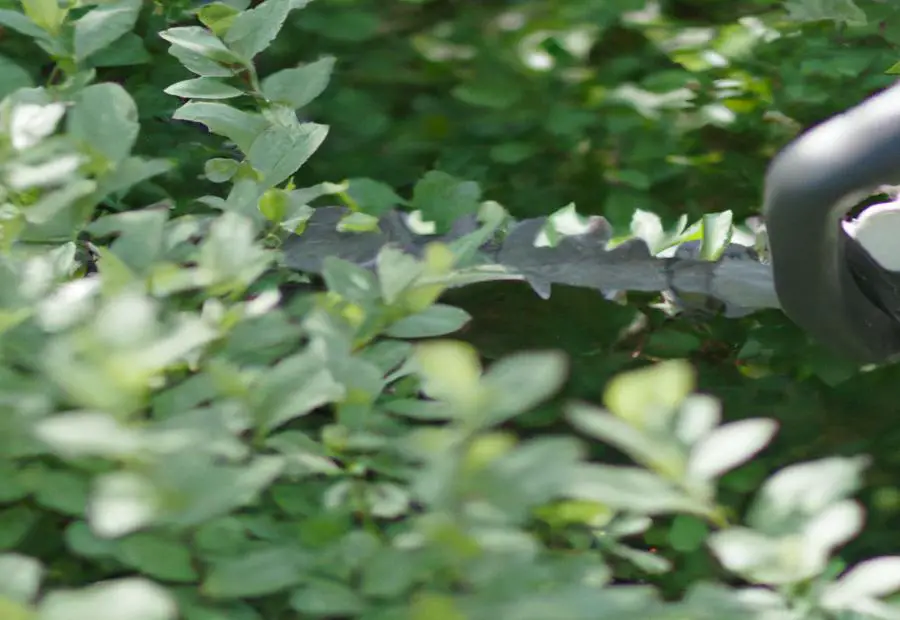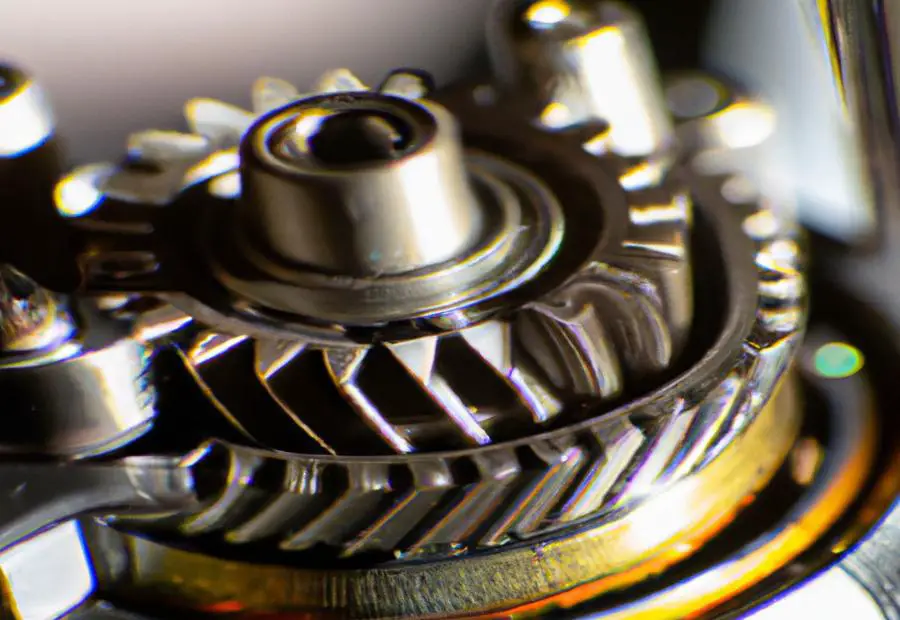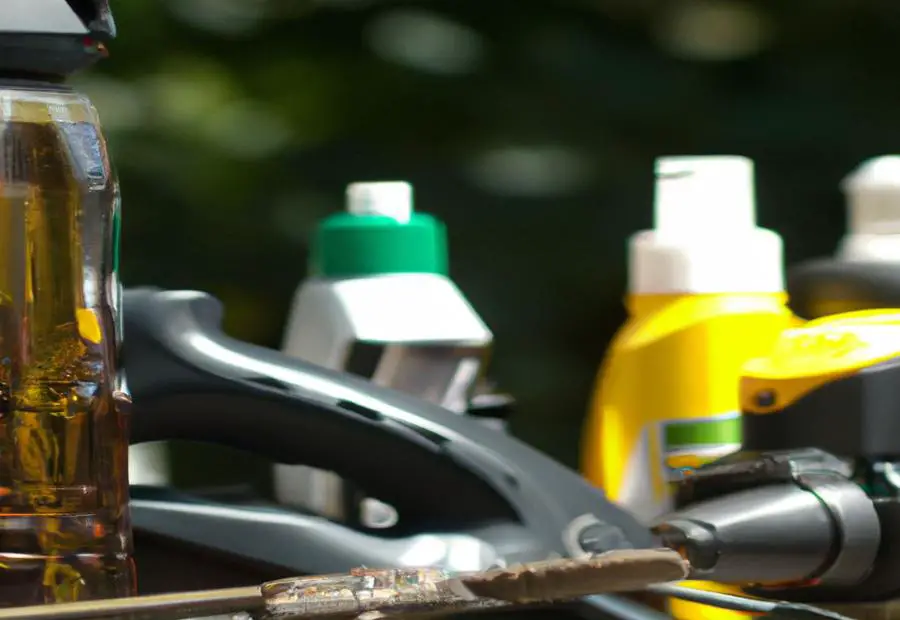GardenerHeaven.com is reader-supported. When you buy through links on our site, we may earn an affiliate commission.
.jpg)

Photo Credits: Gardenerheaven.Com by Russell Wilson
Hedge trimmers play a crucial role in keeping our landscapes well-maintained and aesthetically pleasing. In this section, we’ll delve into the importance of using the right oil for hedge trimmers. We’ll explore the different types of hedge trimmers and their specific lubrication needs. Additionally, we’ll discuss the benefits that come with using different types of oils for hedge trimmers. So, let’s uncover the essential guide and recommendations for choosing the perfect oil to keep your hedge trimmers running smoothly and efficiently.
Lubrication Needs of Different Types of Hedge Trimmers
Lubrication is key for optimal performance and long life of hedge trimmers. The right oil is essential to meet the needs of these tools.
Electric, battery-powered, and gas-powered hedge trimmers are the market’s categories of trimmers. Each type has its own lubrication requirements.
Electric hedge trimmers usually have sealed units. They don’t need regular lubrication, but occasional oiling of blade and gearbox can help reduce friction and ensure smooth operation.
Battery-powered hedge trimmers may need lubrication in specific parts, such as blades and pivoting mechanism. A tiny amount of oil on these components can reduce wear and improve performance.
Gas-powered hedge trimmers require more frequent lubrication due to higher power and vibration. Blades, gearbox, transmission, and engine components need lubrication to reduce wear and keep optimal performance.
Refer to manufacturer instructions or user manual to find out which oil type is suitable for your hedge trimmer model. Wrong oil or insufficient lubrication can reduce performance, increase wear on components, and damage the tool.
Regular maintenance and inspection are also necessary for effective lubrication of hedge trimmers. Clean blades after each use to remove debris that can hinder operation. Store trimmer in a clean, dry environment to prevent corrosion and lengthen its life.
Benefits of Using Different Types of Oils for Hedge Trimmers
Using the correct type of oil is essential for keeping and maximizing the performance of hedge trimmers. Varied oils provide different advantages that ensure smooth running and extend the life of these tools.
- The right lubrication with the suitable oil reduces friction between blades, leading to smoother cutting and increased efficiency.
- Using the proper oil also helps stop early damage to the trimmer’s components like the gearbox and transmission.
- Particular oils are specially made to offer protection from corrosion and rust, shielding the trimmer from harm caused by moisture or exposure to severe outside conditions.
- Also, using different types of oils allows for customization based on individual needs. For example, some oils may function better in hotter climates or provide higher performance in extreme weather.
Also, the right lubrication with the proper oils helps safety when operating a hedge trimmer. The decreased friction means less force is needed when cutting through branches and foliage, lessening the danger of injuries or accidents.
Pro Tip: It is suggested to clean and put on a thin layer of oil on the blades after each use. This guarantees any debris or residue is taken off, preventing it from building up over time and perhaps hindering blade movement.
Choose the right oil for your hedge trimmer: because opting for the wrong one may turn your green thumbs into red thumbs.
Choosing the Right Oil for Your Hedge Trimmer

Photo Credits: Gardenerheaven.Com by Frank Moore
Choosing the right oil is key for your hedge trimmer. It affects performance and lifespan.
- First, find a high-quality oil made for hedge trimmers. These are designed to handle the speed and conditions.
- Second, check the engine type. Two-stroke oils need to be mixed with gas. Four-stroke engines have separate compartments. Read your manual for the type and ratios.
- Third, use synthetic oil for better lubrication and protection – especially in extreme temperatures.
- Finally, select a lightweight oil with a low viscosity. Heavier oil leads to wear and poor performance.
Changing oil and following guidelines help keep performance up and lifespan long. Neglecting this can lead to decreased efficiency and damage.
For best results, consult a professional or the manufacturer. They can recommend oil based on model and usage.
Remember: Clean blades and remove debris before oiling. This prevents clogging and boosts performance.
Proper Maintenance and Lubrication of Hedge Trimmer Blades

Photo Credits: Gardenerheaven.Com by Dylan Scott
Caring for hedge trimmer blades is key for good performance and a long life. Not doing so could cause dull blades and bad cutting. Here are 6 steps to keep your trimmer blades in tip-top shape:
- Clean the Blades: Remove any debris, grass, or branches after every use with a brush or cloth. This prevents clogging and maintains sharpness.
- Inspect for Damage: Look for wear, chips, or damage regularly. Fix them right away by sharpening or replacing the blades.
- Sharpen the Blades: Dull blades make it harder to get good cuts and use up more motor power. Sharpen the blades at least once a season or as needed.
- Apply Lubrication: Proper lubrication helps the blades move smoothly and cuts down on friction. Use a specific oil made for hedge trimmers for best results.
- Store Correctly: Keep the trimmer in a dry and clean area when not in use. Cover it up to protect from harsh weather.
- Regular Maintenance: Follow the manufacturer’s instructions for regular maintenance, such as checking screws, inspecting the motor, and replacing worn parts.
By following these steps, you can make sure your hedge trimmer blades stay sharp and efficient. Prioritize safety and follow the manufacturer’s guidelines for maintenance.
Maintenance Tips for Hedge Trimmer Gearbox and Transmission

Photo Credits: Gardenerheaven.Com by Jacob Jackson
To keep your hedge trimmer’s gearbox and transmission running smoothly, follow these maintenance tips:
- Clean after use – clear away any debris or grass clippings to prevent clogging.
- Inspect for damage – look out for any cracks or leaks, and address them promptly.
- Apply grease – as per the manufacturer’s instructions.
- Check gear teeth – replace any worn or damaged teeth.
- Tighten fasteners – make sure all connections are secured.
- Store correctly – in a dry and secure place, away from extreme temperatures and moisture.
Remember to follow the manufacturer’s guidelines for your hedge trimmer model, too! With these measures, you can ensure your hedge trimmer runs efficiently and reliably.
Proper Cleaning and Storage of Hedge Trimmers

Photo Credits: Gardenerheaven.Com by Austin Taylor
It’s key to clean and store hedge trimmers correctly, or their performance and durability may suffer. This can lead to a drop in the machine’s effectiveness and it could even shorten its life. To guarantee your trimmer stays in top shape, take these simple steps:
- Step 1: After use, brush or wipe away any debris like grass or twigs from the blades. Pay special attention to the tiny places where dirt gathers.
- Step 2: Examine the air filter and clean or change it if needed. A blocked air filter can impact the trimmer’s performance and make it hard to start.
- Step 3: Inspect the spark plug and clean or replace it if required. Worn out spark plugs can cause starting issues or bad engine performance.
- Step 4: Lube the blades and moving parts with suitable oil. Refer to the manufacturer’s instructions for the right type of oil. Regular lubrication cuts down on friction and ensures smooth operation.
- Step 5: Store the trimmer somewhere dry and clean, away from moisture and direct sunlight. It’s wise to use a protective cover to stop dust and dirt from gathering on the machine.
- Step 6: Before long-term storage, empty the fuel tank or add fuel stabilizer to keep fuel degradation from happening. This is particularly important if you won’t be using the trimmer for a while.
By following these steps, you can keep your hedge trimmer performing and lasting well. Cleaning and storing properly will save you money and time on repairs. It’ll also guarantee your trimmer is ready to go when you need it.
Remember to clean and store your trimmer regularly. Check the air filter, spark plug and lube the blades and moving parts often. Storing the trimmer in a clean and dry area and maintaining the fuel system will keep it going for longer. Taking these steps will make sure your hedge trimmer works reliably and efficiently for the length of its life.
Common Problems with Hedge Trimmers and Troubleshooting Tips

Photo Credits: Gardenerheaven.Com by Stephen Hall
Hedge trimmers are must-haves for a spick-and-span garden, but like any tool, they can have issues. Let’s look at some tips to fix these common problems with hedge trimmers and keep your trimmer in good shape.
- Blade Jamming: Blades can get stuck when cutting thick branches or overgrown plants. Turn off and disconnect the power source first. Then, check the blades for any debris or branches causing the jam. Clear ’em out with a brush or small tool. Lube the blades often to avoid this issue.
- Lack of Power: Check if the power source (battery or plug) is fully charged and connected properly. If fine, inspect the blades for dullness or damage. Sharpen or replace them if needed.
- Starting Difficulties: Clogged fuel filter, dirty spark plug, improper fuel mix – these can make starting hard. Fill the tank with fresh fuel and the right oil-to-gas ratio. Clean or replace the fuel filter and spark plug if needed. Also, inspect the ignition system for loose connections or damaged parts.
- Vibration and Noise: Excessive vibration and noise can be caused by loose components (handles, blade guards) or worn-out parts. Tighten any loose screws or nuts. If it persists, have the trimmer serviced by a professional to check for internal damage or worn-out parts.
Refer to the manufacturer’s manual for more info on specific issues or maintenance requirements. Address any problems quickly and maintain your trimmer regularly to keep your hedges looking nice. Heed safety guidelines to ensure a safe trimming experience.
Conclusion: The Importance of Using the Best Oil for Hedge Trimmers

Photo Credits: Gardenerheaven.Com by Joseph Sanchez
Choosing the right oil for hedge trimmers is essential. Data provides info on which kind to use. It’s important to select oil based on manufacturer’s advice and model type.
The data highlights the need for high-quality lubrication oil. This reduces friction and wear on the engine, leading to smoother operation and better performance. Plus, it can improve engine durability and extend its life.
The data also emphasizes the need for oil specifically formulated for small engines. Hedge trimmers have these kinds of engines, so using special oil will give optimal lubrication and protection from heat and stress. This leads to improved reliability and performance.
The data even gives recommendations on specific oil types for hedge trimmers. A high-quality 2-cycle oil (oil/gas mix) is suggested. This is specifically designed for the 2-cycle engine commonly found in hedge trimmers. Proper fuel-to-oil ratio is also important to maintain engine function and prevent damage.
Using the best oil for hedge trimmers is very important. It helps maintain performance, lifespan, and reliable operation. Following manufacturer’s advice and using correct oil designed for small engines will give optimal performance and minimize risk of damage.
Some Facts About “What Type of Oil for Hedge Trimmers? Essential Guide and Recommendations”:
- ✅ Hedge trimmer blades should be regularly lubricated to prevent sticking and ensure clean cuts. (Source: Team Research)
- ✅ The recommended oil for hedge trimmers can be found in the manual or any type of tool oil like WD-40 can be used. (Source: Team Research)
- ✅ Different methods can be employed to lubricate hedge trimmers, such as dipping blades in oil, spraying oil directly, using a cloth, or other online methods. (Source: Team Research)
- ✅ Hedge trimmers should be lubricated before and after use to prevent sap from sticking and remove accumulated debris. (Source: Team Research)
- ✅ Regular lubrication helps maintain the trimmer’s condition and prepares it for storage. (Source: Team Research)
FAQs about What Type Of Oil For Hedge Trimmers? Essential Guide And Recommendations
What type of oil should I use for my hedge trimmer?
Answer: The type of oil to use for your hedge trimmer depends on the specific trimmer and its recommendations. However, some suitable options include 3-in-1 multipurpose engine oil, SAE20 engine oil, Ingersoll Premium Grade Air Tool Oil, and Quicksilver 2-Stroke Oil.
Can I use WD-40 or solvent oils to lubricate my hedge trimmer?
Answer: It is best to avoid using WD-40 or solvent oils as lubricants for hedge trimmers. These are not effective lubricants and can harm plants. It is recommended to use high-grade engine oil or plant-safe lubricating oils.
How often should I oil my hedge trimmer?
Answer: It is recommended to oil your hedge trimmer before and after each use to prevent sticking and remove debris. Additionally, reapply oil every 30 minutes during use to ensure smooth operation.
What should I do if my hedge trimmer blades are sticking?
Answer: If your hedge trimmer blades are sticking, try cleaning them with a wire brush to remove any organic material. Then, apply oil to the blades, ensuring to cover all joints and corners prone to rusting. Regular oiling and maintenance can help restore the blades to their optimal condition.
Is it necessary to clean my hedge trimmer blades before oiling them?
Answer: Yes, it is important to clean your hedge trimmer blades before oiling them. Use a stiff brush and cloth to remove any dirt, debris, or organic residue. This helps prevent corrosion and ensures the blades operate smoothly.
How should I store my hedge trimmer?
Answer: When storing your hedge trimmer, it is recommended to keep it in a dry storage area, such as a shed or garage, away from moisture and the elements. The trimmer can be laid flat on a worktable or hung by its handle. Taking proper storage precautions helps prolong the trimmer’s lifespan.



